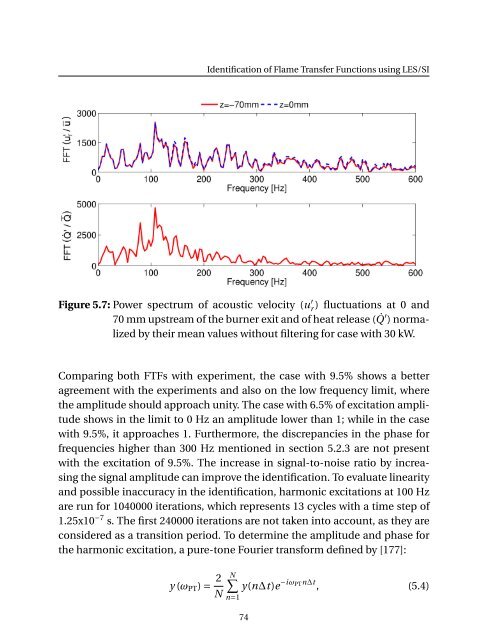Numerical Simulation of the Dynamics of Turbulent Swirling Flames
Numerical Simulation of the Dynamics of Turbulent Swirling Flames
Numerical Simulation of the Dynamics of Turbulent Swirling Flames
You also want an ePaper? Increase the reach of your titles
YUMPU automatically turns print PDFs into web optimized ePapers that Google loves.
Identification <strong>of</strong> Flame Transfer Functions using LES/SI<br />
Figure 5.7: Power spectrum <strong>of</strong> acoustic velocity (u r ′ ) fluctuations at 0 and<br />
70 mm upstream <strong>of</strong> <strong>the</strong> burner exit and <strong>of</strong> heat release ( ˙Q ′ ) normalized<br />
by <strong>the</strong>ir mean values without filtering for case with 30 kW.<br />
Comparing both FTFs with experiment, <strong>the</strong> case with 9.5% shows a better<br />
agreement with <strong>the</strong> experiments and also on <strong>the</strong> low frequency limit, where<br />
<strong>the</strong> amplitude should approach unity. The case with 6.5% <strong>of</strong> excitation amplitude<br />
shows in <strong>the</strong> limit to 0 Hz an amplitude lower than 1; while in <strong>the</strong> case<br />
with 9.5%, it approaches 1. Fur<strong>the</strong>rmore, <strong>the</strong> discrepancies in <strong>the</strong> phase for<br />
frequencies higher than 300 Hz mentioned in section 5.2.3 are not present<br />
with <strong>the</strong> excitation <strong>of</strong> 9.5%. The increase in signal-to-noise ratio by increasing<br />
<strong>the</strong> signal amplitude can improve <strong>the</strong> identification. To evaluate linearity<br />
and possible inaccuracy in <strong>the</strong> identification, harmonic excitations at 100 Hz<br />
are run for 1040000 iterations, which represents 13 cycles with a time step <strong>of</strong><br />
1.25x10 −7 s. The first 240000 iterations are not taken into account, as <strong>the</strong>y are<br />
considered as a transition period. To determine <strong>the</strong> amplitude and phase for<br />
<strong>the</strong> harmonic excitation, a pure-tone Fourier transform defined by [177]:<br />
y (ω PT ) = 2 N<br />
N∑<br />
y(n∆t)e −iωPTn∆t , (5.4)<br />
n=1<br />
74
















